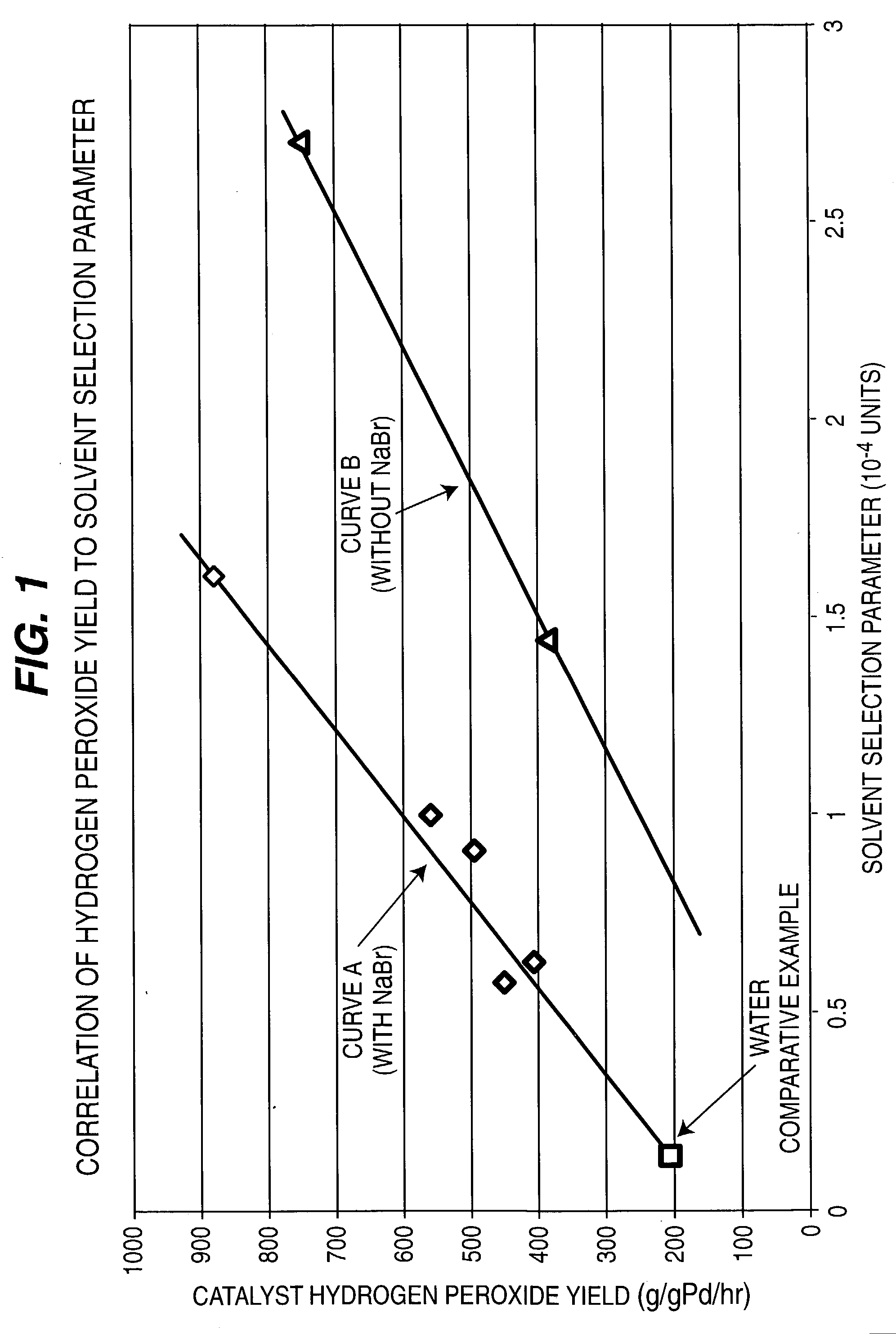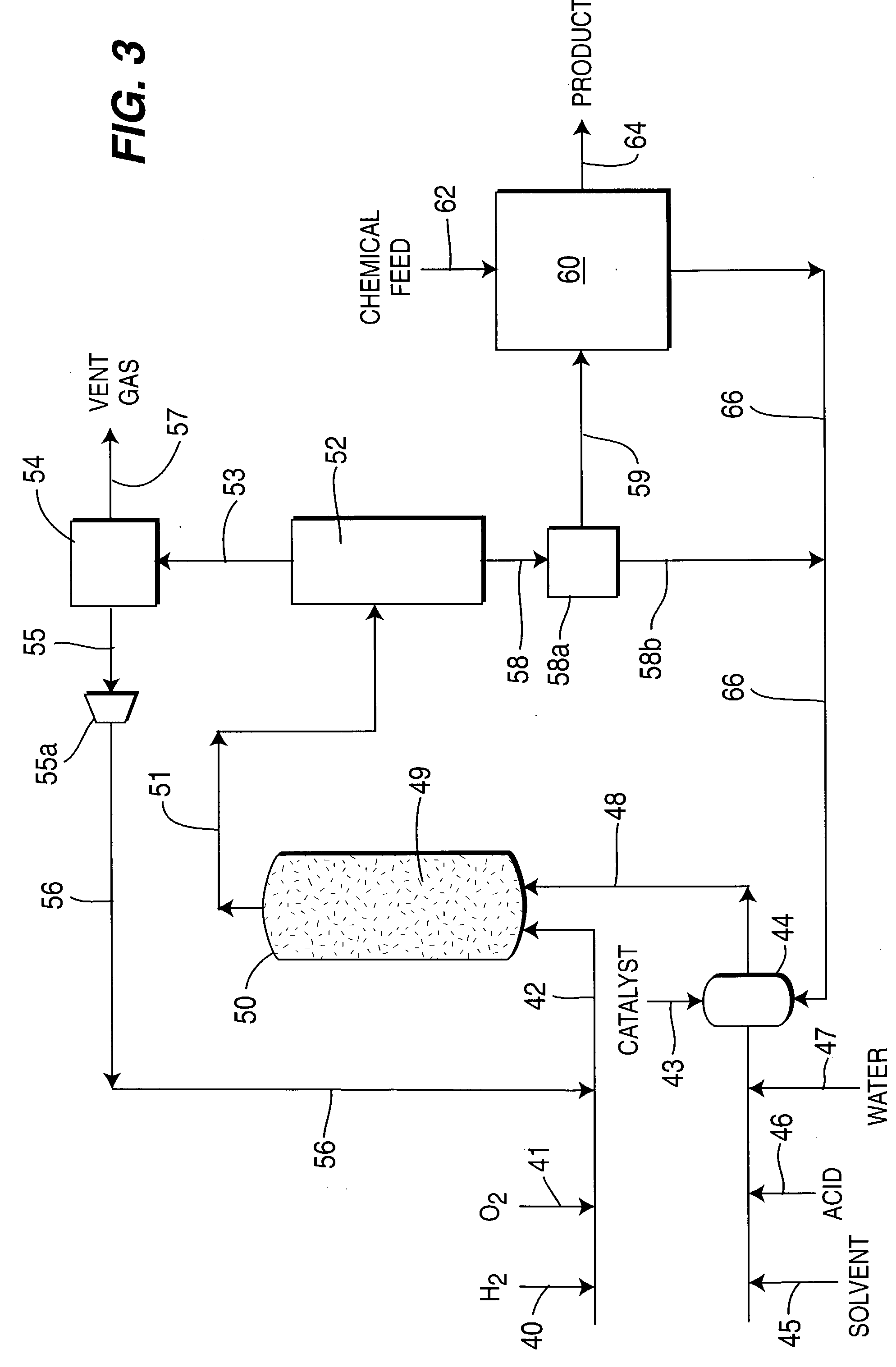Hydrogen peroxide production using catalyst particles with controlled surface coordination number
a technology of surface coordination and hydrogen peroxide, which is applied in the direction of catalyst activation/preparation, metal/metal-oxide/metal-hydroxide catalysts, physical/chemical process catalysts, etc., can solve the problems of high capital and operating costs, safety problems, and transportation of hydrogen peroxide from a production site to an end-user facility, and achieves reduced production cost, and improved catalyst hydrogen peroxide yield
- Summary
- Abstract
- Description
- Claims
- Application Information
AI Technical Summary
Benefits of technology
Problems solved by technology
Method used
Image
Examples
example no.1
EXAMPLE NO. 1
[0091] 50 ml of water and 0.5 g phase-controlled palladium catalyst having a surface coordination number of 2 were introduced into a 1-liter capacity stirred autoclave unit together with 1 wt. % sulfuric acid (H.sub.2SO.sub.4) and 5 ppm NaBr. and having a liquid Solvent Selection Parameter (SSP) of 0.14.times.10.sup.-4. Reaction conditions were maintained at 45(C temperature and 1400 psig pressure at gas feed rate of 1.0 liter / minute of feed gas containing 3% hydrogen in air. After 3 hours reaction time, hydrogen conversion reached to 24.3%. Liquid product was analyzed by titration with potassium permanganate, and 2.9 wt % concentration of hydrogen peroxide product was obtained at a yield of 207 g / g Pd / h. The examples and results are all tabulated in Table 1, and are shown graphically as FIG. 1.
example no.2
EXAMPLE NO. 2
[0092] The water solvent in Example No. 1 was replaced by 75 ml of 30 vol. % methanol and 70 vol % water, having an increased Solvent Selection Parameter of 0.578.times.10.sup.-4. The methanol was totally miscible with water, and 0.25 g phase-controlled palladium catalyst was used with 1 wt % (H.sub.2SO.sub.4) and 5 ppm NaBr. After 2 hours reaction time, hydrogen conversion was 22.0% and 2.1 wt % concentration of hydrogen peroxide was obtained and yield increased to 450 g / g Pd / h.
example no.3
EXAMPLE NO. 3
[0093] The methanol in Example No. 2 was replaced by acetonitrile which provided a Solvent Selection Parameter of 0.626.times.10-4. The acetonitrile was miscible with water. After 2 hours reaction, hydrogen conversion was 18.9% and 1.9 wt % concentration of hydrogen peroxide was obtained with a yield of 407 g / g Pd / h.
PUM
| Property | Measurement | Unit |
|---|---|---|
| pressure | aaaaa | aaaaa |
| temperature | aaaaa | aaaaa |
| particle sizes | aaaaa | aaaaa |
Abstract
Description
Claims
Application Information
 Login to View More
Login to View More - R&D
- Intellectual Property
- Life Sciences
- Materials
- Tech Scout
- Unparalleled Data Quality
- Higher Quality Content
- 60% Fewer Hallucinations
Browse by: Latest US Patents, China's latest patents, Technical Efficacy Thesaurus, Application Domain, Technology Topic, Popular Technical Reports.
© 2025 PatSnap. All rights reserved.Legal|Privacy policy|Modern Slavery Act Transparency Statement|Sitemap|About US| Contact US: help@patsnap.com



